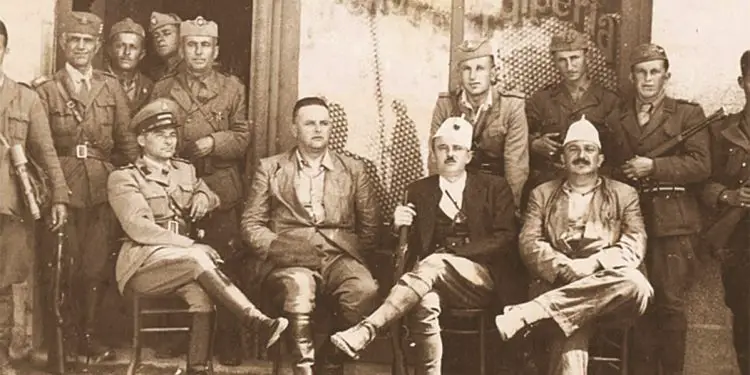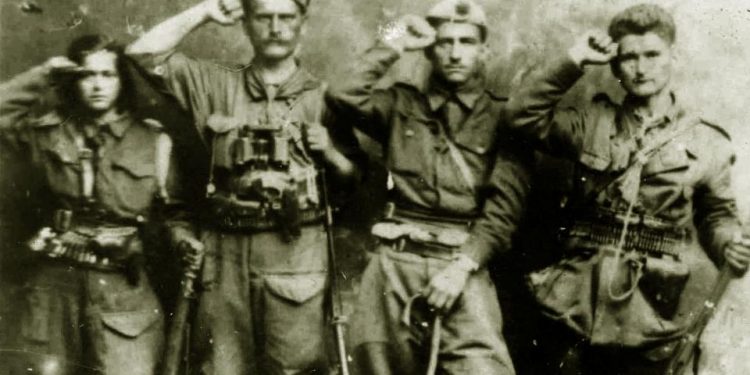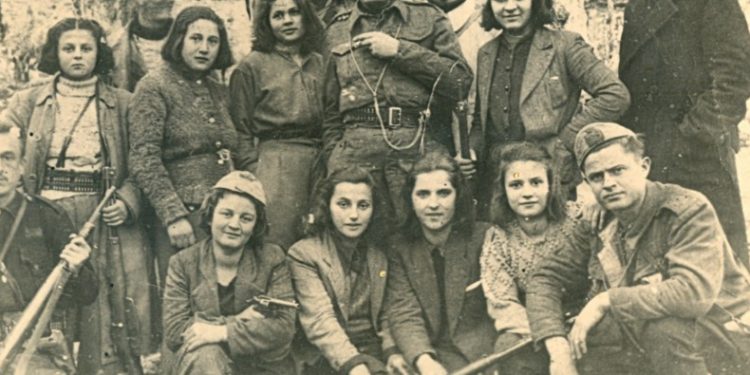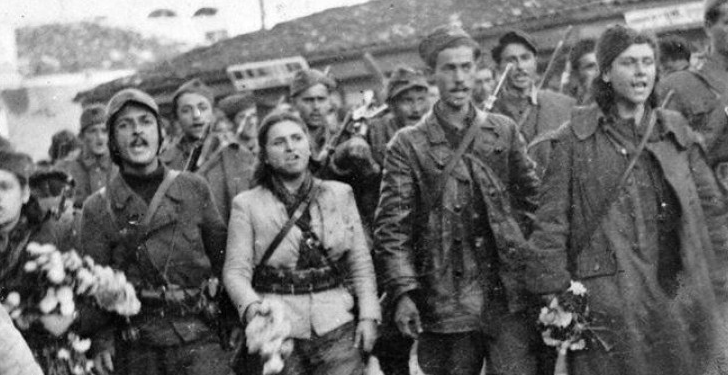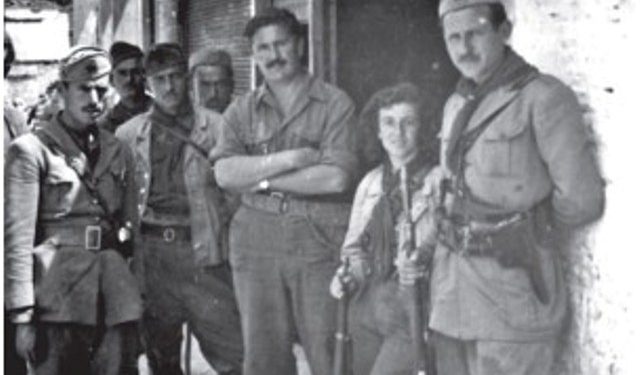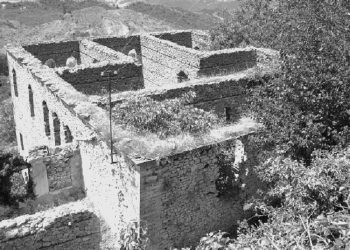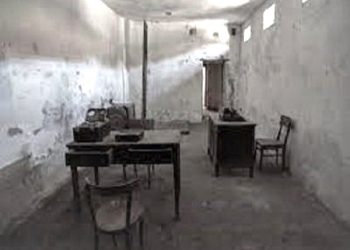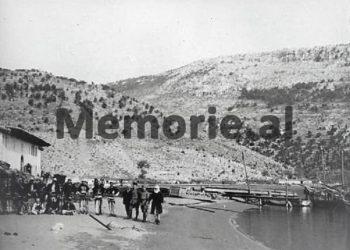Dashnor Kaloçi
Memorie.al / brings back the memories of Hamit Matjani’s son, Xhavit, regarding the much talked about event of 1943 where Mehmet Shehu’s First Partisan Brigade captured and executed 67 villagers who had been mobilized with the nationalist forces of Balli Kombëtar and their execution made 19-year-old partisan, Emine, B, who after the war was given the high title, “People’s Heroine”… ?!
The much talked about event of the execution of 67 Musketeer villagers on the distant October 17, 1943, which for years a fierce debate between the two main forces of Albanian politics, as well as their supporters, comes for Memorie.al, witnessed by one of the few eyewitnesses, Xhavit Matjani, evidence he gave us a few years ago. when and passed away. Xhaviti was the only son of Hamit Matjani, a well-known exponent of the anti-communist resistance in Albania, who was hanged in 1954 in the middle of the city of Lushnja, after entering Albania several times illegally. Xhaviti, together with his mother and sister, spent their whole lives in exile and only after 1991, they returned to Tirana, where he lived for several years and then moved to the US, where he was stabilized by the US government. for the merits and service rendered by his father, Hamit, in the anti-communist resistance. Xhavit was only ten years old when the 67 ballista prisoners were shot, but he remembered very well the event that this article is about. Along with the story of Xhavit Matjani, in this article comes the story of a former partisan cadre of the First Brigade of Mehmet Shehu, who preferred to remain anonymous.
The massacre took place after the breach of the Mukje Agreement
It had been more than a month and a half since Enver Hoxha, the leader of the Communist Party and at the same time the General Commander of the Partisan Army, had broken the agreement reached in Mukje of Kruja, between his emissaries and the top leaders of the organization. “Ballit Kombëtar”, which sanctioned these two political-military forces to engage in joint actions, against the invading Italian army and later the German one. This had greatly aggravated the conflict situation between them, leading to armed efforts, especially in the areas where partisan brigade formations were operating, which had just been formed. In this context, sometime in the second half of October 1943, on the outskirts of Lushnja in the village of Çermë, after an armed attempt between a part of the partisan forces of the First Brigade commanded by Mehmet Shehu and The nationalist forces of the “National Front” commanded by Isa Manastiriliu, had happened what is now known as one of the darkest spots in the history of partisan war led by Enver Hoxha, where within minutes the members of this brigade, executed with machine gun fire . full of 67 ballists.
How did the clash between the partisans and the ballistas take place?
The First Partisan Brigade led by Mehmet Shehu that had only been established in Vidhkuq of Korça for less than two months, with partisans selected by the main battalions, which at that time were operating in Central and Southern Albania, (where in its inauguration except Enver Hoxha would be attended by members of the Anglo-American missions (aletae), had a few days had focused its combat activity in the triangle of Mallakastër-Lushnje-Durrës area. In those days in the city of Lushnja was held a very important meeting of the nationalist forces of the “National Front” which was attended by some of its main commanders who came from Tirana.
This meeting was scheduled to be held in Lushnje, because there “Balli Kombëtar” had one of the strongest bases of its influence. Isa Manastiriliu’s squad (of Kosovar origin) operated there, and besides him there was an absolute authority, also Hamit Matjani, who at that time continued to be with the government forces, as a gendarmerie commander for some districts of Central Albania. Regarding the armed attempt that took place between the forces of Isa Manastiriliu and those of Mehmet Shehu, there are two versions, how it happened.
In communist historiography, it is said that it was Mehmet Shehu’s partisan forces who plotted the attack, having previously obtained accurate data on the location of Manastirili’s ballistic forces. That helped them deliver the blow, locking them in a tight siege, which put the ballistas in front of a forced surrender. The other version, defended by the supporters of “Balli Kombëtar”, suggests that it was Isa Manastiriliu’s forces, who occupied the ambush at the place where the First Shehu Brigade would pass, after Manastiriliu had received an order for this from the Command of forehead.
It is said that Isa Manstiriliu was informed by the Lushnja District Command, on the afternoon of October 23, 1943, about the movements of a part of Mehmet Shehu’s partisans, towards the villages of Golem and Çermë, where he organized the ambush. According to all the information that Manastiriliu had, the partisan forces crossed into the area where he was concentrated and waited for their arrival. It is said that the armed struggle lasted for several hours and there the Shehu partisan forces, being more numerous and much more militarily prepared, quickly began to annihilate all the remaining Balli forces in the area. Seeing the situation in which the forces of Balli Kombëtar were, their commander Isa Manastiriliu, ordered their withdrawal in the direction of Lushnja, to be closed in the city, where the partisan forces could not enter. The order given by Manastirili for withdrawal was impossible to go to all his forces due to the terrain, but also due to the speed of the partisan forces, which managed to dominate the situation. No more than an hour after the armed struggle began, fighting ceased and some of Manastirili’s forces, unable to retreat further into Lushnja, surrendered after about 12 people had been killed. After the surrender of the ballistic forces, Shehu’s partisans disarmed and it turned out that the number of surrendered was 173 people. Most were all young people under the age of 30, who were villagers from the Divjaka, Çermë, and Golem areas.
Shehu: Execution of ballistas, in the village of Hamit Matjani?!
It is said that after the disarmament of the Ballista captives, they were accompanied by some partisans of the First Brigade. Mehmet Shehu himself decided that his brigade, together with the Ballista prisoners, should leave Golem in the direction of the village of Matjan, where was also the house of one of the most important commanders of Balli in this area, Hamit Matjani, who was also a staunch opponent of communist forces. According to some testimonies, Hamit Matjani was not in Lushnje that day because he was in some villages of Berat.
Evidence of his absence in Lushnje is made known by his own son, Xhavit Matjani, who at that time was about 10 years old, one of the few people who witnessed the execution of ballista prisoners. Regarding this, in 1998, Xhavit Matjani testified to us: “The news about the arrival of Mehmet Shehu’s partisans in our village, caused the whole village to leave with great speed. There were only a few elders left in the village and we, about six children, of whom I was the eldest. Around midnight, the First Brigade arrived in our village of Matjan and took the captives into a building in the house of Nure Matjan (our father Hamit’s cousin) which served as a barn to keep cattle but was walled. thick of stone. The next night, on October 24, as soon as the day dawned, the captives were selected and 67 people were held, who were sent to the village cemetery… “, Xhavit Matjani recalled that distant event, which these days has taken place subject to numerous debates between the main political forces and their supporters.
Testimony: “19-year-old partisan executed 67 prisoners of war”
Regarding this event, the former partisans of Enver Hoxha’s partisan army also have their version, where one of them, a former member of the First Brigade of Mehmet Shehu, who during the years of communism held high leadership positions, testifies to the event: “After the selection of the ballistic prisoners was made and about 100 of them were released, 67 of them lined them up near a hill in the village cemetery, telling them that if they joined the partisan forces and to fight alongside them, their lives would be spared. Otherwise they would be shot.
None of the 67 prisoners agreed to leave the line and sign the declaration for joining the ranks of the partisan forces. One of them, whom the partisans hoped to break, as he had great influence on others who asked him if he wanted to become a communist or not, after much pressure, he replied, “I’d rather be a pig than a communist.”
That would be enough for the communist partisan forces of Mehmet Shehu’s First Brigade, apparently taking orders from their command, for their immediate execution without trial. The command of the First Brigade, decided that their execution would be carried out with a machine gun by a 19-year-old partisan, named, Emine B. And so, it was. All the ballistic prisoners, fell two by two, under the barrage of bullets of the partisan machine gun. After the execution was over, some partisans went to the houses of the village elders, telling them that; leave the corpses there for 3-4 days and do not move them.
After the departure of Mehmet Shehu’s Brigade in the direction of Dumre, the elders and other inhabitants of the village of Matjan, hurried to the cemetery to see what had happened. After the liberation of Albania, based on that event, the former partisan, E. B. was awarded the high title, “People’s Heroine” which was and remained the only woman who enjoyed this high title.
Haxhi Lleshi: “Enver Hoxha gave Mehmet a serious remark”.
The event in the village of Matjan would mark the prologue of a fratricidal war that had begun in Albania, between Enver Hoxha’s partisans and the nationalist forces of Balli Kombëtar. And this happened only a short time after the break-up of the Mukje Agreement, where initially both sides signed a cooperation agreement for a joint war. In that period, this event caused a great commotion in both Balli and partisan forces. From that time onwards, it has remained a mystery whether Enver Hoxha himself knew about the execution of the ballistas and this was done with his permission, or on the initiative of Mehmet Shehu himself, when it is known that Enver Hoxha himself, together with The General Staff, at that time, was located not far from Lushnja, in the villages of Elbasan.
The version that Hoxha gave the order to Shehu, or rather approved his order, can become more credible given the fact that only a few weeks later, such a thing was repeated on the Italian captives in Dumre Elbasan, where over 110 people were shot. The story of the village of Matjan, during the period of communist rule was never made public and was never written even in the history of the Anti-Fascist National Liberation War. Only after the elimination of Mehmet Shehu in 1981, Enver Hoxha in his work “Titoists”, made public the fact that once in 1943, in a village of Lushnja, Mehmet Shehu had shot without the order of the General Staff, 67 ballistas, and according to Hoxha, he had severely criticized him.
Regarding the massacre of the First Brigade, in 1994, the former Chairman of the Presidium of the People’s Assembly, Haxhi Lleshi, testified (for the author of the article, interview on TV ARBERIA), who, among other things, stated that “I am Mehmet Shehu I knew him in 1943, that he came late to the war, after he had been outside Albania, and that at the head of the First Brigade, he came after we learned that he was an excellent military strategist, who had taken part in the Spanish War . At the beginning of 1944, as a member of the General Staff of the Partisan Army, I had a meeting with Mehmet. We were discussing the attack that our army would make in the North of Albania, after crossing the Shkumbin River, when Mehmeti told me: ‘Haxhi, when we go to Debar, to shoot at least 300 men, because the reaction there is very strong ‘. No, I said bluntly, what are we terrorists? And I continued, look here you Mehmet, be careful, because you did the same with those ballistas in Myzeqe. They were not all guilty, and therefore only 3-4 of them could be shot who were the most important, but not all and this is a big mistake. Enver Hoxha also harshly criticized Mehmeti regarding the execution of the ballistae. Of the rest of us, I do not know that we have had cases where we have undertaken mass executions like the one in Lushnja, except for some isolated cases where only the main leaders of Balli have been shot. I remember that even a senior partisan commander had the opportunity to take such steps to allow executions of this kind. “But I do not know of any other executions of this nature committed by any of our friends.”
Consequences of the Balli conflict with the communists, in the village of Matjan
According to the testimonies of Xhavit Matjani, for almost half a century, the village of Matjan, which in the distant October of 1943, experienced the communist massacre, would bear the “stain of the reactionary village”, being such for the sole reason that it was the village of Hamit Matjani, one of the most prominent exponents of the anti-communist movement in post-war Albania, executed by hanging on a rope in the middle of Lushnja in 1954, after entering Albania several times as a saboteur. And based on this fact, only the first two or three years after the communists came to power, his cousins would shoot in the Matjani family, Ibrahim, Hamit’s brother, Hasan and Hajdar Matjani, nephews, Veli and Asllan Matjani imprisoned Fatime Matjani, Hamit’s wife.
In the same way, the communist regime of Enver Hoxha would treat some other families of that village, supporters of Balli Kombëtar, such as Blliku and Kurti. Unlike Hamit Matjani who at that time would continue the armed resistance on the mountain against the State Security Pursuit Forces (who would arrest him after Operation Lake Vajkal in 1953, and sentence him to death), chapter I The National Front of the Lushnja area, Isa Manastiriliu, would escape with the help of the Anglo-Americans in 1944, to settle in the United States of America. Manastirilu would die in 1980, just one year before his opponent Mehmet Shehu./Memorie.al
List of 67 shot
- Ndoni Miti Sako
- Fani Zoi Trungu
- Gori Siku Todi
- Jani Spiro Gjoka
- Jorgji Xhovan Lala
- Kozma Andon Zhuka
- Koli Xhovan Tashi
- Kristo Joti Shkoza
- Nasi Spiro Zhuka
- Loni Naun Bita
- Llazi Llambi Prifti
- Liti Nasi Shkoza
- Mihal Tasi Bita
- Nasi Simon sako
- Nasi Lalzi Janko
- Nasi Leksi Zaho
- Perikli Kozma Prendi
- Pali Teni Zaka
- Ristan Gjergji Bani
- Simo Nuni Gjini
- Stefan Ndoni Prendi
- Trifon lexi Gjata
- Trifon Kozma Gjoni
- Todi Spiro Gjergji
- Vasil Koçi Përboti
- Myslym Haxhi Bedalli
- Ram Koçi
- Bajram Jeshili
- Medi Pirra
- Bajram Pepa
- Ruho Nako
- Hysen Dupi
- Arif Muço
- Rakip Xhepa
- Shaqir Sula
- Elmaz Xhepa
- Çaush Xhepa
- Hysen Ismaili
- Shyqyri Leka
- Arif Halili
- Trifon John
- Shaban Sina
- Asllan Vrapi
- Latif Karafili
- Murat Meshani
- Bajram Bilbili
- Ismail Koçiu
- Isuf Buzi
- Ramazan Kofsha
- Shefik Tota
- Gori Lala
- Ndin Ndoni
- Gaqo Ndoni
- Beqir Cani
- Sabri Bullari
- Tafil Lluzha
- Ibrahim Lluzha
- Haxhi Sina
- Shemsi Arapi
- Cen Arapi
- Haxhi Murrizi
- Kadri Murrizi
- Hysen Murrizi
- Ismail Murrizi
- Alush Kasemi
- With Kasemi





